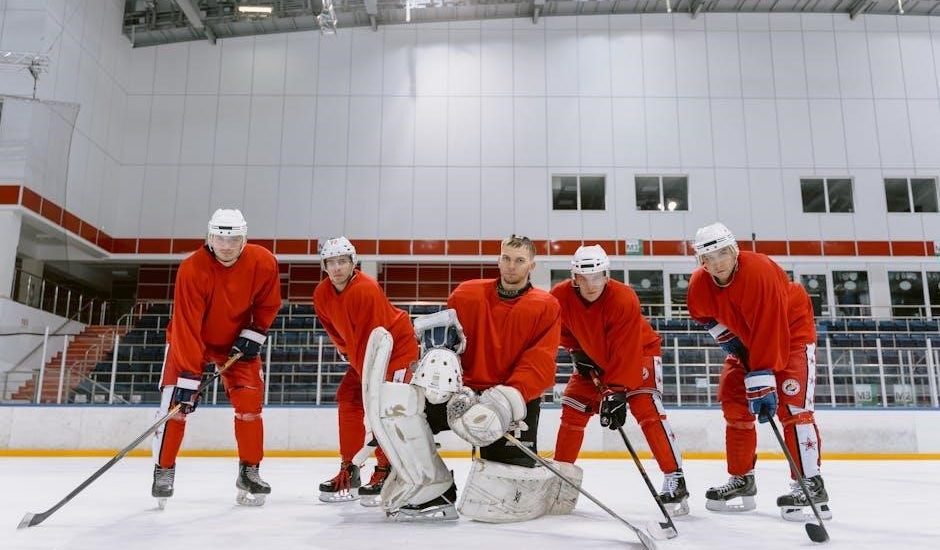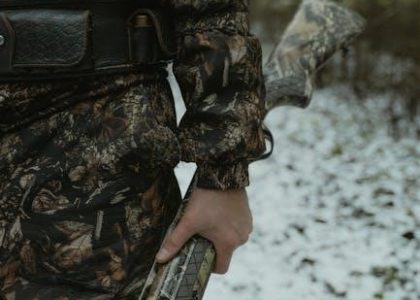Choosing the right goalie pad size is crucial for performance and protection. Use measurements like Ankle-to-Knee (ATK) and Floor-to-Knee (FTK) to determine your ideal fit. Proper sizing ensures mobility, coverage, and comfort, essential for goalies to perform at their best.
Properly sizing goalie pads is essential for optimal performance and protection. Goalies require equipment that allows for mobility while providing adequate coverage. The sizing process involves measuring key areas like the ankle-to-knee (ATK) and floor-to-knee (FTK) distances, which help determine the ideal pad length. Skate size, body proportions, and playing style also influence the fit. With so many brands offering varying fits, understanding how to measure and choose the right size is crucial. This guide will walk you through the steps to ensure a perfect fit, whether you’re a youth player or a seasoned pro, helping you perform at your best on the ice;
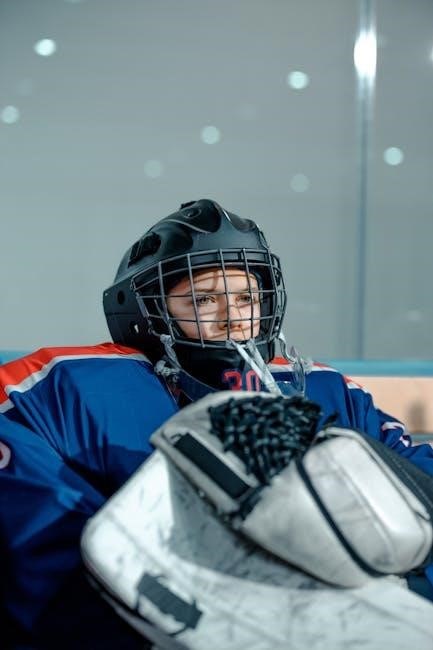
Importance of Proper Fit in Goalie Pads
A proper fit in goalie pads is crucial for both performance and protection. Ill-fitting pads can lead to reduced mobility, leaving gaps that opponents can exploit. Conversely, pads that are too tight may restrict movement, hindering a goalie’s ability to make saves. Properly sized pads ensure optimal coverage, allowing goalies to move freely and confidently. They also distribute impact forces evenly, reducing the risk of injury. Additionally, a well-fitted pad enhances overall performance by maintaining balance and stability. With so many factors influencing fit, such as body proportions and playing style, selecting the right size is essential for peak performance on the ice.
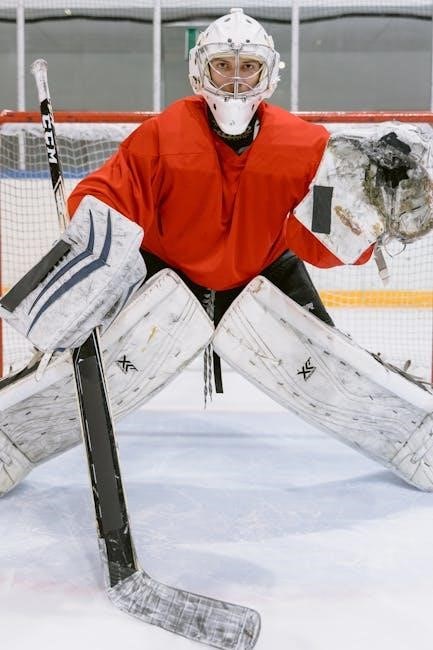
Understanding Goalie Pad Measurements
Goalie pad measurements are critical for determining the right fit. Common measurements include Ankle-to-Knee (ATK) and Floor-to-Knee (FTK), which help calculate pad length accurately for optimal protection and mobility.
Ankle to Knee (ATK) Measurement
The Ankle-to-Knee (ATK) measurement is a key factor in determining goalie pad size. To measure ATK, sit with your knee slightly bent and measure from the heel of your skate to the middle of your knee. This measurement helps ensure proper fit and mobility. For example, an ATK of 18 inches often corresponds to a 34-inch pad. However, consider your height and body proportions, as some goalies with longer legs may need a larger size; Always refer to brand-specific sizing charts, as variations exist. A well-fitted pad ensures optimal performance and protection.
Floor to Knee Measurement
The Floor-to-Knee (FTK) measurement is another essential factor in goalie pad sizing. To measure, sit straight with your knee bent at a 90-degree angle and measure from the floor to the center of your knee. This measurement helps determine the overall length of the pad needed for proper coverage. For example, an FTK of 20 inches may suggest a 34-inch pad. However, this can vary depending on brand and style. Combining FTK with Ankle-to-Knee (ATK) measurements ensures a more accurate fit. Always consider your height, leg length, and skating style when interpreting FTK results. Proper sizing enhances mobility and protection.
Skate Size and Its Relation to Pad Size
Skate size can serve as a general reference for goalie pad sizing but isn’t always the most accurate method. While some brands use skate size to estimate pad size, others rely more on direct leg measurements. For example, a size 8 skate might correspond to a 34-inch pad, but this varies by brand and fit preferences. Skate size alone doesn’t account for leg length or personal comfort. Combining skate size with measurements like Ankle-to-Knee (ATK) or Floor-to-Knee (FTK) provides a more accurate fit. Always consult brand-specific sizing charts, as some manufacturers tailor their pads to different skating styles and preferences.
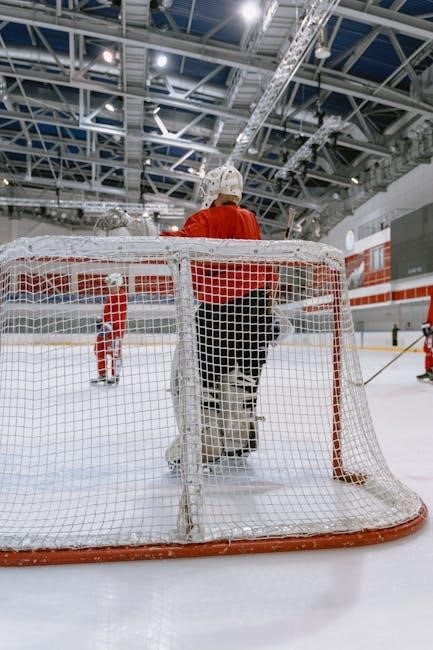
Factors Influencing Goalie Pad Size
Height, body proportions, and playing style significantly impact goalie pad size. Proper fit ensures mobility and protection, catering to youth, junior, or senior levels of play.
Height and Body Proportions
Height and body proportions play a significant role in determining goalie pad size. Taller goalies may require longer pads for proper coverage, while shorter goalies need shorter pads to maintain mobility. Body proportions, such as leg length and torso size, also influence fit. For example, a goalie who is 5’10” with longer legs may prefer a 35″ pad, while a 5’10” goalie with shorter legs might opt for a 34″. Proper fit ensures pads stay in place, providing both protection and flexibility. Consider torso length and leg-to-torso ratio to avoid pads that are too long or too short, ensuring optimal performance and comfort.
Playing Style and Preference
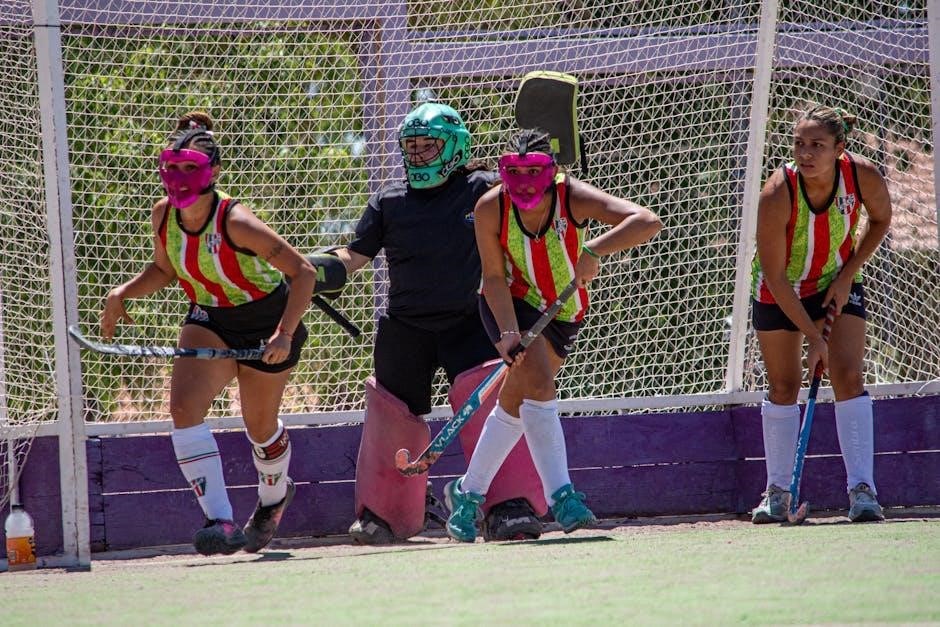
Playing style and personal preference significantly influence goalie pad size. Goalies who adopt a butterfly style often prefer shorter pads for better mobility, while those favoring a stand-up style may opt for longer pads for increased coverage. Some goalies prioritize flexibility and ease of movement, leading them to choose slightly shorter pads, while others prefer maximum protection, opting for longer pads. Personal comfort and performance needs also play a role, as pads that feel too restrictive or bulky can hinder a goalie’s ability to react quickly. Ultimately, the right pad size aligns with both the goalie’s technique and their confidence in the gear.
Level of Play (Youth, Junior, Intermediate, Senior)
The level of play significantly impacts goalie pad sizing, as different skill levels require varying degrees of protection and mobility. Youth goalies typically use shorter pads (22-25 inches) to accommodate smaller frames and ensure proper movement. Junior players often transition to slightly longer pads (26-30 inches) as they grow and develop their skills. Intermediate and Senior goalies usually opt for pads in the 29-38 inch range, depending on their height, leg length, and playing style. Higher levels of play demand more durable and specialized gear, but proper sizing remains critical to maintain performance and protection. Always consider growth potential for younger players when selecting pad size.
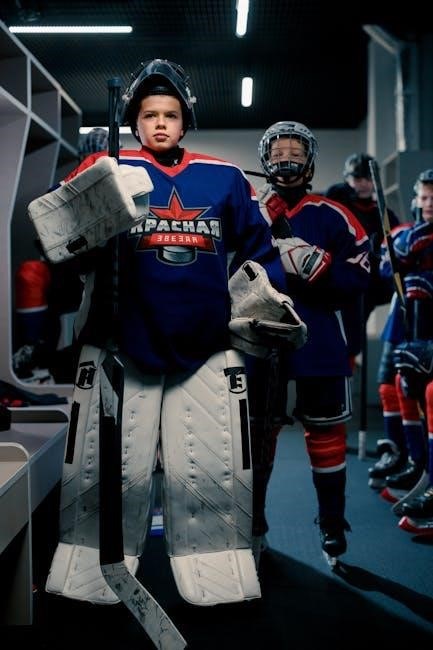
Goalie Pad Components and Their Sizing
Goalie pads consist of leg pads, a catcher’s glove, blocker, and chest protector. Each component is sized to fit the goalie’s body, ensuring protection and mobility. Proper sizing is key.
Leg Pad Sizing Chart
Leg pad sizing charts provide a structured guide to selecting the right pad size based on a goalie’s height and leg measurements. Youth sizes typically range from 22-25 inches, suitable for younger players with shorter legs. Junior sizes, 26-30 inches, cater to growing goalies, while intermediate sizes (29-32 inches) and senior sizes (32-38 inches) are designed for older, taller players. Proper fit ensures optimal protection and mobility. Always consult brand-specific charts, as sizing may vary slightly between manufacturers. Using your Ankle-to-Knee (ATK) or Floor-to-Knee (FTK) measurements is recommended for accurate sizing. This chart helps goalies find pads that align with their body proportions and playing style.
Catcher’s Glove and Blocker Sizing
Catcher’s gloves and blockers are sized based on age and hand size, ensuring proper fit and functionality. Youth sizes range from 3-6, junior from 7-12, intermediate from 12-14, and senior from 13 and above. To measure, place the glove on your hand, ensuring your fingers fit comfortably with padding covering your wrist. Hand circumference and finger length are key factors. Brands may vary slightly, so consult specific sizing charts. A well-fitting catcher’s glove and blocker allow for better control and protection, essential for goalies to perform effectively. Proper sizing ensures optimal performance and safety during games.
Chest and Arm Protector Sizing
Chest and arm protectors are sized based on age groups, with youth sizes for younger players and senior sizes for adults. Proper fit ensures protection and mobility. Measure around the chest at nipple level, ensuring the protector covers the shoulders and upper arms. Arm length should fit comfortably within the protector’s sleeves. Sizes range from small to extra-large, corresponding to age categories. Brands may vary slightly, so consult specific sizing charts. A well-fitting chest and arm protector prevents restricted movement while providing adequate coverage. Ensure the protector aligns with your body shape and playing style for optimal performance and safety during games.
How to Choose the Right Goalie Pad Size
Measure accurately, consider brand-specific fits, and ensure pads match your height, skating style, and level of play for optimal comfort and protection.
Tips for Trying On Pads
When trying on goalie pads, wear your skates and hockey socks for an accurate fit. Ensure the pads sit comfortably, with the knee landing in the center. Bend your knee to check mobility and ensure the pads don’t shift excessively. Opt for a snug fit to prevent gaps but allow enough room for movement. Consider brand-specific sizing differences, as fits can vary. If buying online, refer to sizing charts and reviews for guidance. Test the pads while standing and in a butterfly position to assess coverage and flexibility. A proper fit ensures protection, comfort, and optimal performance during games.
Considering Brand-Specific Sizing Differences
Brand-specific sizing can vary significantly, so it’s crucial to consult each manufacturer’s sizing chart. Some brands cater to taller goalies with longer pads, while others focus on a more compact fit. Always review customer feedback and product descriptions to understand how a particular brand’s sizing runs. For example, one brand might label a 34-inch pad as fitting a 5’10” goalie, while another may suggest a 35-inch pad for the same height. Trying pads on in person is ideal, but if buying online, use brand-specific guides and consider reaching out to customer support for personalized recommendations to ensure the best fit.
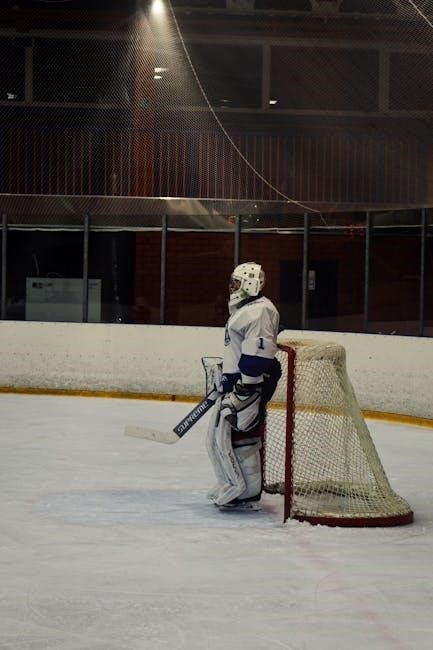
Common Mistakes in Goalie Pad Sizing
Overestimating or underestimating measurements and ignoring brand-specific fit differences are common errors. Ensure accurate sizing by using industry-standard methods and consulting brand guides to avoid poor fit and performance issues.
Overestimating or Underestimating Measurements
One common mistake is misjudging measurements like Ankle-to-Knee (ATK) or Floor-to-Knee (FTK). Overestimating can lead to oversized pads, reducing mobility, while underestimating risks insufficient protection. Use a flexible tape measure, bend knees slightly, and ensure accuracy. Double-checking measurements and consulting brand-specific charts helps avoid errors. Proper fit is essential for both performance and safety, so take time to measure correctly and consider seeking advice from experienced goalies or equipment experts to ensure optimal sizing and comfort.
Ignoring Brand-Specific Fit Differences
Different brands often have unique sizing standards, and ignoring these can lead to poor fit. For example, a 34″ pad from one brand might fit differently than a 34″ from another. Always consult brand-specific sizing charts, as some brands cater to taller goalies while others suit more compact builds. Failing to account for these variations can result in pads that are too tight or too loose, affecting mobility and protection. To avoid this, research the brand’s fit profile and consider trying pads on if possible. This ensures a tailored fit that aligns with your body type and playing style for optimal performance.
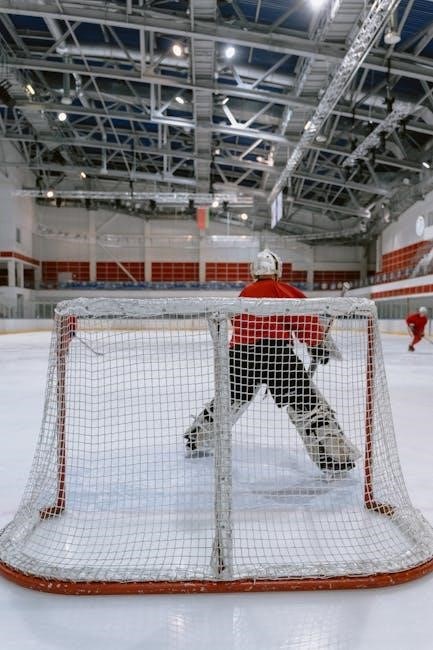
Maintenance and Fit Adjustment
Regular cleaning and proper storage are essential for maintaining goalie pad performance. Clean pads prevent odor and maintain flexibility, while proper storage preserves their shape and support.
Breaking In New Goalie Pads
Breaking in new goalie pads is essential for optimal comfort and performance. Start by wearing them during light practice or drills to allow the pads to mold to your legs. Applying heat, such as using a hair dryer, can soften the material and reduce stiffness. Avoid using excessive heat, as it may damage the padding. Ensure the pads are snug but not restrictive, as improper fit can lead to discomfort or blisters. Consistent use helps the pads conform to your body, improving mobility and protection. Properly breaking in your pads ensures they perform as intended, enhancing your goaltending experience.
Adjusting Pads for Optimal Performance
Adjusting goalie pads is crucial for maximizing protection, mobility, and comfort. Once properly sized, pads can be fine-tuned by tightening or loosening straps and clips to ensure a snug, secure fit. Goalies should stand upright when making adjustments to replicate game positioning. Knee and thigh sections should align with the body’s natural movement, allowing freedom of motion without restriction. Heat molding or professional adjustments can further customize the fit; Regularly checking and tightening straps ensures consistent performance. Proper adjustments prevent shifting during play, maintaining optimal protection and responsiveness. Fine-tuning your pads enhances overall goaltending efficiency and confidence, making it a key part of preparation.

